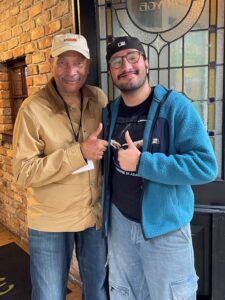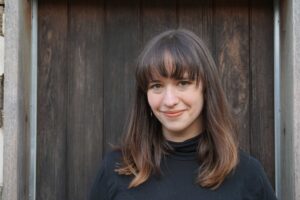Johns Hopkins UniversityEst. 1876
America’s First Research University
In high school, John Guess became enticed by the world of art after visiting the home of a girlfriend. Her mother exposed him to a library full of books and magazines, including The New Yorker, Vanity Fair, and The Atlantic. He also found himself in the household of an art collector, where he discovered his first artwork by a celebrated artist. Guess says he can still see that library, that art and feel the impact of those years.

Growing up in the segregated South in the 1950s and ’60s, Guess says African American cultural items were rarely prevalent in schools in his hometown of Houston. He credits his high school girlfriend’s mother, Nilta Norton, with opening up her library and introducing him to the visual arts.
“Nilta made the difference culturally in my life,” says Guess, A&S ’71, SAIS ’76 (MA). “My family believes in the power of one person. It’s why I give. I became a multiculturalist because of one person, Nilta Norton.”
Today, Guess is the CEO of the Houston Museum of African American Culture. He also sits on the advisory board of Johns Hopkins University’s Homewood Museum.
As an undergraduate, Guess believed being involved in campus organizations was paramount. He was elected the first Black president of the Student Government Association and co-founded the Black Student Union. Guess calls his experience at Hopkins instrumental. It’s the reason why he’s given back to the university since the 1980s, especially supporting diversity and multicultural groups.
“I want to make sure there’s an even playing field,” says Guess. “I want students to receive the full Hopkins experience like I did. My giving is based on trying to be the example to other people of color and particularly African Americans.”
Since joining the Homewood Museum Advisory Board, Guess has pledged funding to support a new type of curatorial internship position at Homewood. The internship runs once a year during the fall semester and facilitates research on the history of African Americans at Johns Hopkins.
“I admire the work the advisory board has already done, but there are still certain needs,” says Guess. “The interns will dig into the history and uncover new details about the museum.”
Homewood is a national historic landmark and was built circa 1801 for members of Maryland’s prominent Carroll family. The house was also home to at least 25 enslaved individuals, including William and Rebecca Ross and their two children and Izadod and Cis Conner and six of their 13 children.
“The museum isn’t just about the Carrolls; it’s about the other people living there and about those who have interacted with Homewood since,” says Guess. “Context is everything.”
Hadeed Habib, a senior at Hopkins, is the first Homewood intern to benefit from Guess’ generosity. He’s researching the history of student-organized protest movements at Johns Hopkins, specifically the Black Student Union sit-in on the Homewood campus, and the university-wide protest of the Vietnam War.
“This history is important,” says Habib, a sociology and art history double major from San Diego. “Coming from today’s perspective, it’s easy to take for granted that these organizations exist on campus when the history of them is really wrought in this idea of civil protest, civil disobedience, and the ongoing relationship with Hopkins.”

Throughout his Homewood internship, Habib has been working directly with Curator of Collections Michelle Fitzgerald, reviewing primary sources, including written oral histories. One of the transcripts is of Guess. The documents provide firsthand accounts of the protest movements from the perspective of Hopkins students who witnessed and participated in the events.
“Protest history can feel broad, but I’m finding interactions between students and the Baltimore community,” says Habib. “The connection between the wideness of it and the localness of it has been interesting.”
Habib’s research will be incorporated into a fall 2025 exhibition at Homewood Museum covering the university’s sesquicentennial and the United States’ 250th anniversary. Fitzgerald says the internship program has been the first opportunity to take a deep dive into the 20th-century history of Homewood for the purpose of an exhibition.
“Every week during our check-ins, Hadeed surprises me with a new story he has uncovered about the JHU student body’s relationship to Homewood in the 1960s and 1970s,” she says. “I’m excited to see the long-lasting impacts his research could have on our understanding of the historic property.”
In September, Habib met Guess in Baltimore where he discussed his internship findings and learned more about Guess’ educational and professional background.
“It was wonderful meeting John,” says Habib. “He was on the ground doing the work in the ’60s. The fact that he is now supporting the historiography — and that this information will be shared at the upcoming exhibit — is influential.”
Fitzgerald agrees and underscores how Hopkins students and donors are integral to the mission of the university’s historic house museums.
“To have John want to develop a new opportunity for students to engage with the museum allows us to expand our capacity for student workers at Homewood and spread the word about the museum among the student body,” she says.
As the internship program continues, Guess hopes Habib and future interns remain active with the university and become advocates for their generation.
From his days at Homewood campus and studying at SAIS Europe in Bologna, Italy, to successfully leading the Houston Museum of African American Culture — Guess says he’ll always be connected to Hopkins and to the City of Baltimore.
“It’s a feeling of home,” he says. “Hopkins is a place where wherever you are in the world, you’re reminded of where you come from because there will always be someone else in the world that went to Hopkins. I’m proud.”
Topics: Sheridan Libraries and University Museums, Strengthening Partnerships